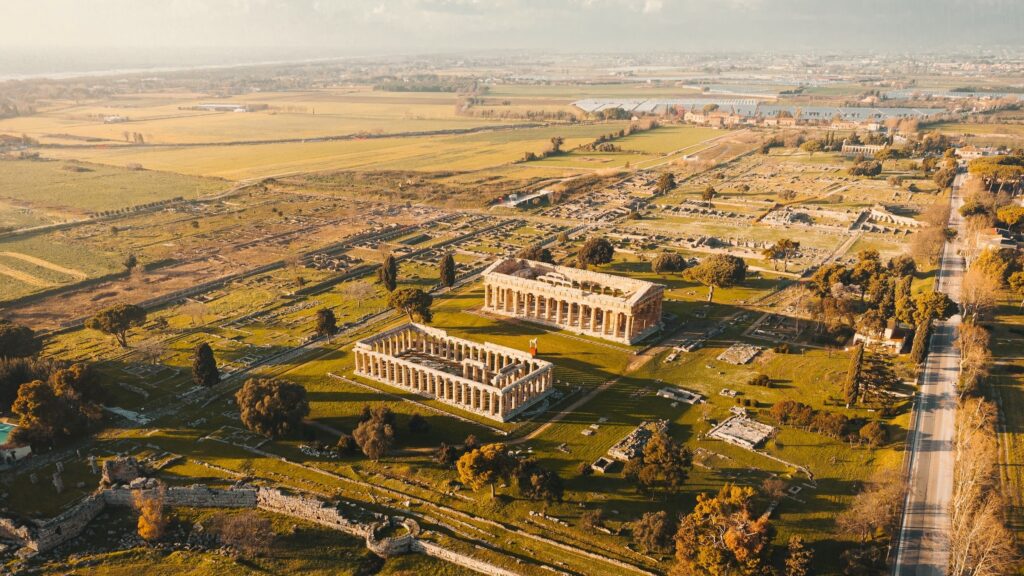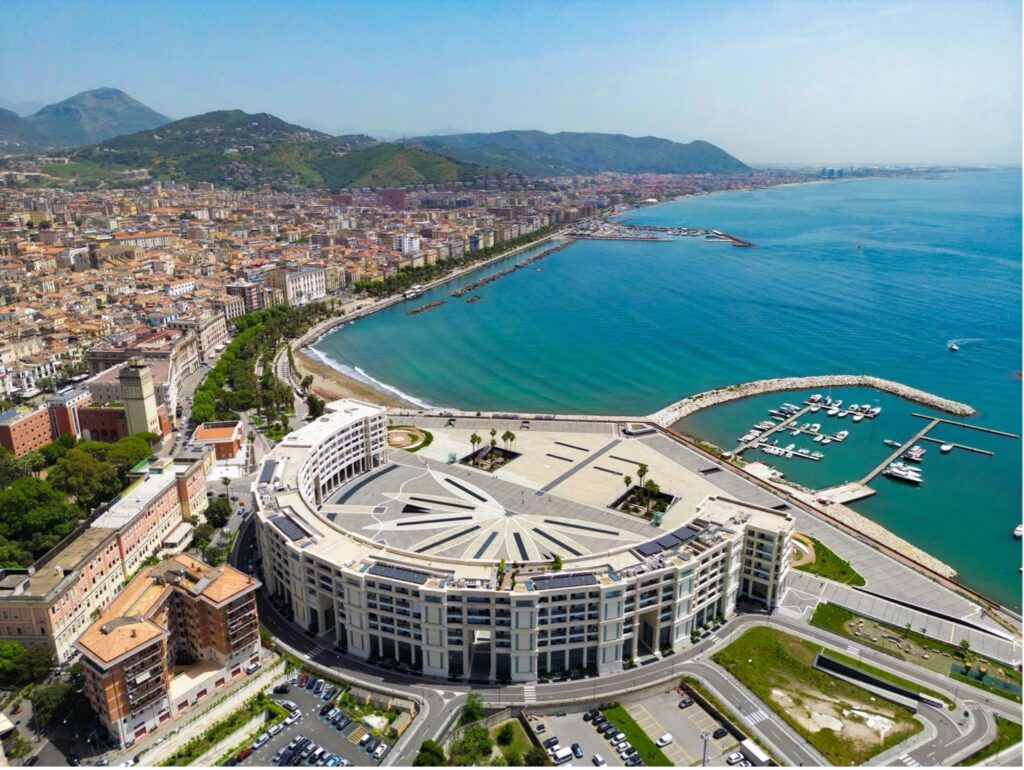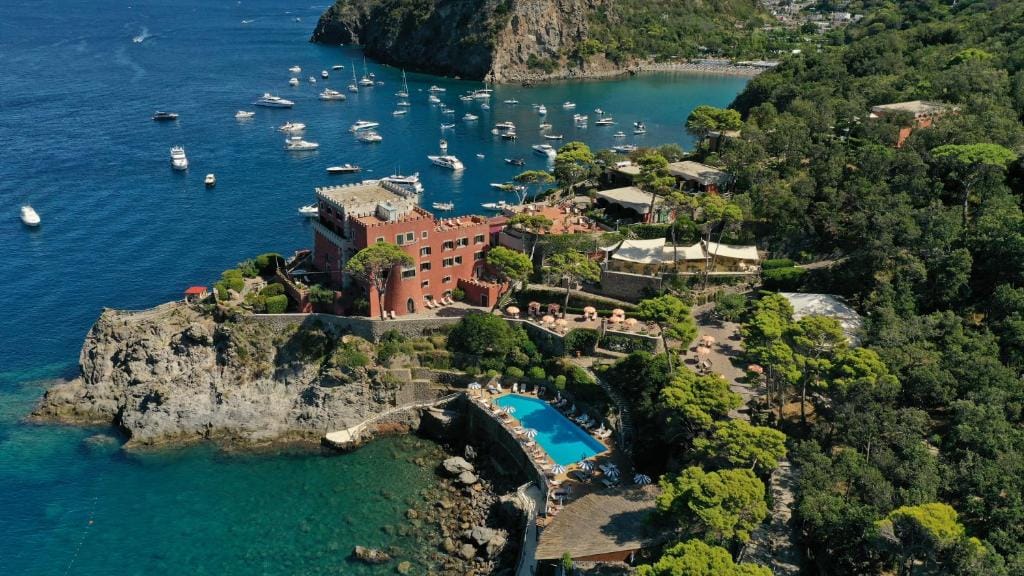Paestum, Campania, is one of the most remarkable archaeological sites in the country. Known for its three well-preserved Greek temples, Paestum offers an unforgettable journey through history, culture, and natural beauty. This UNESCO-listed site combines ancient ruins with the warm charm of southern Italy, making it a must-visit destination for travelers exploring Campania and the Cilento Coast.

Jump to
ToggleWhy Visit Paestum
Paestum was once known as Poseidonia, a Greek colony founded around the 6th century BCE. Today, it is part of the UNESCO World Heritage property Cilento and Vallo di Diano National Park with the Archaeological Sites of Paestum and Velia, and the Certosa di Padula. Visitors can walk among Doric temples, explore a fascinating museum, and enjoy the slower pace of life in Capaccio Paestum and the surrounding countryside.
Unlike Pompeii, Paestum is less crowded and more serene. Its open fields, quiet atmosphere, and impressive ruins create a magical setting for history lovers and casual tourists alike. Standing among the temples as the sun sets is an unforgettable experience, with golden light illuminating the columns.
Paestum Archaeological Park Highlights
Temple of Hera I (the Basilica)
Built around 550–525 BCE, this temple is one of the earliest examples of Doric architecture in Magna Graecia. Known as the Basilica, it was actually dedicated to Hera, the queen of the gods. The massive columns and heavy proportions reflect its archaic style. Walking around its perimeter, visitors can admire the sense of permanence these early builders achieved more than 2,500 years ago.
Temple of Hera II (Temple of Neptune)
Constructed around 460–450 BCE, this is the best-preserved temple in Paestum. Often called the Temple of Neptune, it is more accurately dedicated to Hera. Its harmonious proportions and sense of balance showcase the transition into Classical architecture. The temple’s thick columns still stand proudly, and visitors can walk between them, imagining the rituals and gatherings that once took place here.
Temple of Athena (Temple of Ceres)
Built around 500 BCE, this temple blends Doric and Ionic styles. It was long thought to be dedicated to Ceres, but archaeologists now identify it as a sanctuary for Athena. Its elevated position offers wonderful views across the site and the surrounding plains. From here, the modern countryside stretches out towards the Cilento Coast, linking past and present in one panorama.
The Ancient City Walls and Forum
Beyond the temples, Paestum preserves parts of its ancient city walls, which stretched for nearly five kilometers. Gates and watchtowers still stand, offering a sense of the fortified nature of the settlement. In the center lies the forum, once the bustling civic heart where markets, speeches, and gatherings took place. Exploring these areas adds depth to the experience beyond the iconic temples.
Paestum Museum and the Tomb of the Diver
The National Archaeological Museum of Paestum houses treasures excavated from the city and nearby necropolises. The star attraction is the Tomb of the Diver, a painted Greek tomb dating to around 475 BCE. Its frescoes are unique in Greek art, depicting a young man diving into water, symbolizing the passage to the afterlife.
Other highlights include painted Lucanian tombs, ancient sculptures, pottery, weapons, and everyday objects that reveal details of life in Magna Graecia. The museum also explains the shift from Greek to Roman control of the city and how the inhabitants adapted to new rulers and cultures.
Visitor Information
Paestum Tickets
Entrance tickets are valid for three days and cover both the archaeological site and museum. The ticket allows one entry to the Paestum archaeological area and museum, plus one entry to the site of Velia. Buying tickets online in advance is recommended in high season, but they are also available on-site.
Paestum Opening Hours
The archaeological park is typically open from 08:30 to 19:30, with last entry and ticket office closing around 18:30. The museum’s last entry is usually around 19:00. Hours may vary seasonally, so always check the official website before visiting.
Suggested Visit Duration
Plan at least two to three hours to explore the temples and museum. If you also visit Velia, reserve half a day more. For a relaxed pace, consider staying overnight in Capaccio Paestum so you can visit the site at different times of day.
Where to Stay in Paestum
Paestum has a good selection of hotels, guesthouses, and family-run accommodations. Many are located near the archaeological park or along the sandy beach. Options range from boutique hotels with views of the temples to seaside resorts perfect for summer holidays. Staying overnight allows you to enjoy the ruins in the quieter hours of the day and combine your visit with a beach escape.
Top Rated Hotels in Paestum
1) 🔍Borgo La Pietraia
Hilltop retreat with pool and Mediterranean gardens overlooking the Cilento coast.
Score: 9.5/10 (≈250 reviews).
Review: “Amazing breakfast with figs… very nice and spacious room.”
2) 🔍Tenuta Duca Marigliano Boutique Hotel
Elegant boutique stay near the UNESCO temples, with gardens and refined dining.
Score: 9.1/10 (≈662 reviews).
Review: “Great family owned hotel… Perfect for walking to Paestum.”
3) 🔍Boutique Hotel Esplanade
Stylish beachfront hotel with private beach club access and a large pool.
Score: 9.0/10 (≈267 reviews).
Review: “Beachclub 96 is included… we felt very welcomed.”
4) 🔍Paestum Inn Beach Resort
Seafront resort with private beach, bikes, and a relaxed contemporary vibe.
Score: 8.8/10 (≈466 reviews).
Review: “Lovely room, excellent evening meal and breakfast buffet.”
5) 🔍Mec Paestum Hotel
Modern design hotel close to the archaeological site, with two pools and private beach.
Score: 8.6/10 (≈1,207 reviews).
Review: “The hotel was lovely… The staff were amazing.”
Top Rated Villas & Farm Stays in Paestum
1) 🔍PrimeQuerce (Farm stay)
Rustic-chic rooms on a working buffalo farm, with generous breakfast featuring house-made dairy.
Score: 9.1 (343 reviews)
Review: “Buffalo-milk cappuccino, ricotta and mozzarella… staff very friendly.”
2) 🔍Portasirena Agriturismo (Farm stay)
Historic farmhouse with a large pool and on-site restaurant, close to the ancient temples.
Score: 8.9 (186 reviews)
Review: “Close to the ruins… beautiful pool… delicious dinner.”
3) 🔍Azienda Agrituristica Seliano (Farm stay)
Charming countryside estate with spacious rooms, excellent homemade dinners, and relaxed vibe.
Score: 8.6 (294 reviews)
Review: “So peaceful… staff are so friendly… excellent food.”
4) 🔍Hera Paestum Suite con Piscina privata (Villa)
Modern suite with private indoor pool, hot tub, and sauna—luxury for couples or small groups.
Score: 9.5 (45 reviews)
Review: “Everything… absolutely stunning! Five-star luxury feel.”
5) 🔍Villa Ginevra (Villa)
Beachside villa with garden and terraces, perfectly located near both the sea and the ruins.
Score: 9.4 (71 reviews)
Review: “Great location… next to the beach and a short walk to the ruins.”
Top Rated Apartments in Paestum
1) 🔍Residence La Voce del Mare
Modern apartments with pool and garden, just a short walk from the beach.
Score: 9.8 (19 reviews)
Review: “Brand new and super clean.”
2) 🔍VENART by AnrealeRooms
Stylish, fully equipped apartments about 10 minutes from Licinella-Torre di Paestum beach.
Score: 9.7 (69 reviews)
Review: “Really great value, especially outdoors shower!”
3) 🔍Luli Holidays Paestum
Spacious family-friendly flat with kitchen, close to both the beach and archaeological site.
Score: 9.6 (27 reviews)
Review: “…just a few minutes to the beach… host went above and beyond.”
4) 🔍Residenza Rizzo Paestum
Comfortable serviced apartments with balconies, near the sea and with private parking.
Score: 9.4 (43 reviews)
Review: “Parking privé; plage à proximité à pieds.”
5) 🔍Villa Vimani
Apartments with access to a pool, modern interiors, and multi-bedroom options for families.
Score: 9.1 (104 reviews)
Review: “Everything was clean, nice and modern.”
Food and Local Experiences
Mozzarella di Bufala
The Piana del Sele, near Paestum, is home to many buffalo farms. Visitors can tour dairies, watch the cheesemaking process, and taste fresh mozzarella straight from the source. Pair it with local tomatoes, olive oil, and bread for a perfect southern Italian meal.
Local Cuisine
Other regional delights include seafood from the Cilento Coast, fresh pasta dishes like scialatielli, and traditional desserts such as pastiera or sfogliatella. Dining in Capaccio Paestum combines authentic flavors with a warm southern Italian welcome. Many restaurants offer outdoor terraces, where you can enjoy meals under the stars.
Events and Festivals
Each year, Paestum hosts cultural events such as concerts and theatre performances staged among the ruins. The Borsa Mediterranea del Turismo Archeologico (BMTA) is an annual fair dedicated to archaeological tourism, attracting visitors and experts from around the world. It usually takes place in late October or early November.
Getting to Paestum
Naples to Paestum Train
Trenitalia operates direct trains from Naples Centrale to Paestum. The fastest direct services take about 1 hour–1 hour 20 minutes; slower runs can take longer. Once you arrive at Paestum station, it’s a short walk to the archaeological park.
Salerno to Paestum
From Salerno, regional trains take about 40 minutes to reach Paestum. This makes Paestum an excellent excursion for those staying along the Amalfi Coast. Travelers coming from Sorrento or Amalfi can combine bus and train connections via Salerno.
By Car
Driving to Paestum offers flexibility and the chance to explore the Cilento Coast afterwards. From Naples, take the A3 motorway towards Salerno and then continue on the SS18 south. Parking is available near the site.
Paestum vs Pompeii
Travelers often compare Paestum and Pompeii. Pompeii is larger and offers a vivid snapshot of Roman life, but it is also busier and more commercial. Paestum, with its Greek temples and peaceful atmosphere, offers a different kind of magic. Here, the temples rise from meadows dotted with wildflowers, and you can take your time without feeling rushed. Ideally, visit both to appreciate Campania’s layered history, but if you prefer serenity, Paestum may be the better choice.
Exploring the Cilento Region
Velia (Elea)
Included in the Paestum ticket, Velia is an ancient city famous as the home of philosophers Parmenides and Zeno. It lies about an hour south of Paestum and offers ruins of city walls, towers, baths, and an acropolis. Walking its paths, you can sense the intellectual energy that once flourished here.
Cilento Coast
South of Paestum stretches the Cilento Coast, a less-visited area of Campania with sandy beaches, fishing villages, and delicious local cuisine. Towns like Agropoli and Castellabate make wonderful stops for travelers seeking authentic Italian life. The Cilento and Vallo di Diano National Park, part of the UNESCO designation, also offers hiking trails and natural wonders.
Capaccio Paestum
The modern town of Capaccio Paestum offers hotels, restaurants, and easy access to both the archaeological site and the seaside. It is also known for producing Mozzarella di Bufala Campana DOP, a regional specialty. Visiting a local dairy to taste this cheese fresh is an essential experience.
Best Time to Visit Paestum
Spring and autumn are the most pleasant seasons, with mild temperatures and fewer crowds. Wildflowers in spring add color to the fields around the temples. Autumn brings harvest festivals and food events celebrating local products. Summer can be hot, but the nearby beaches offer refreshing breaks, and the long daylight hours allow extended visits. Winter is quiet, with fewer visitors and a different kind of atmosphere. Misty mornings add a mystical aura to the ruins.
Tips for Visiting Paestum
Wear comfortable shoes; the site is large and mostly outdoors.
Bring water, especially in summer months.
Allow time for the museum, not just the temples.
Pair your visit with Velia or a stop along the Cilento Coast.
Visit early morning or late afternoon for fewer crowds and better light.
Combine your trip with a mozzarella farm tour for a full local experience.
Recheck opening hours before traveling, as seasonal adjustments are common.
FAQs About Paestum
Is the Temple of Neptune really dedicated to Neptune?
No. The so-called Temple of Neptune is actually dedicated to Hera.
Are Paestum tickets valid for Velia?
Yes. The standard ticket includes both Paestum and Velia, valid for three days.
How long does it take to visit Paestum?
Two to three hours are enough for the temples and museum. Add extra time for Velia.
How do you get from Naples to Paestum?
Direct trains take around 1 hour to 1 hour and 20 minutes, depending on the service.
Is Paestum worth visiting compared to Pompeii?
Yes. Paestum offers a quieter, more intimate experience, with world-class temples in a peaceful setting.
Can you visit Paestum with children?
Yes. The wide-open spaces make it easy for families, and kids often enjoy running among the ruins.
Final Thoughts
Paestum, Campania, is a destination that blends ancient history, natural beauty, and local traditions. From its majestic Greek temples to its unique museum treasures, Paestum offers an experience that feels both timeless and refreshingly authentic. Whether as a day trip from Naples or part of a longer exploration of the Cilento Coast, Paestum deserves a place on every traveler’s itinerary.
Plan your trip today and walk among the temples of Paestum—where history still speaks in stone.
Disclosure: This page may contain affiliate links. This means that we get a small commission from any purchase you make, at no additional cost to you!

